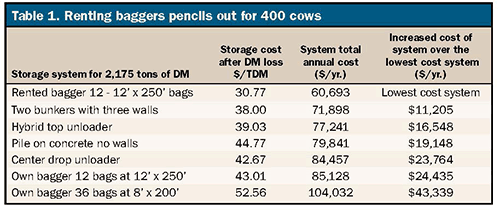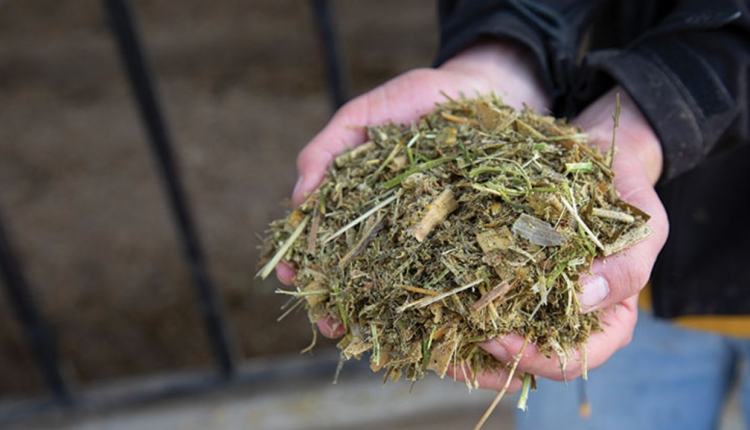Booher is a farm business instructor at Lakeshore Technical College. Holmes is a professor and extension specialist in the biological systems engineering department, University of Wisconsin-Madison.
Producers and consultants often jump to the conclusion that flat feed storage is the most economical. They could be wrong.
A producer's future plans and how well they can manage their feeding system makes all the difference in whether to build flat feed storage, tower silos or use a silage bagging system.
In 2011, we assisted a farmer with his plan for expansion from 200 to 400 cows. He used upright silos but wondered if they should build flat concrete silage storage or try large poured concrete silos. Then, in 2012, a 400-cow dairy asked us to evaluate exchanging their silage bags for another forage storage system.
We watched the second farm put up corn silage last fall. Their 550-horsepower, 12-foot, self-propelled bagger is capable of unloading and packing up to 13 tons of feed per minute. The feed is dumped onto a feeder table, runs into the bagger and packed all in one operation. Think about that! In bunker silos, the feed must be dumped, pushed onto the pile in thin layers and packed with one or more heavy tractors.
The feed storage decision is extremely complex. Considerations include required daily silage face removal, cost of the storage structures, current forage storage system used on the farm, speed in filling and feeding, and space to store feed. It is also worth mentioning the problems associated with upright silos and unloaders in very cold weather. Producers with center-drop and top-unloading systems have talked very positively about the dependability of their modern upright silos.
Too expensive to waste
Waste and dry matter loss are very big concerns, especially with today's feed costs. The storage system decision is heavily affected by how good of a job the operator does in putting up silage and how conscientious they are about feedout, hence reducing costly dry matter loss or shrink.
To determine a silage storage cost, we used the cost of producing 160 bushels of corn per acre or approximately 20 tons per acre corn silage at 35 percent dry matter. The University of Wisconsin Custom Rate Guide was used to determine the cost of tillage, spreading fertilizer and pesticide application, planting, chopping with a kernel processor and hauling the corn silage to the silo structure.
The cost incurred in this process was just over $600 per acre, including $150 per acre cost of land. At 20 tons of corn silage per acre, the cost was $30.10 per ton at 35 percent dry matter (DM).
Our study looked at farms requiring 2,175 tons of DM corn silage. We compared center-drop and top-unloading poured concrete silos, aboveground bunkers with walls, packed piles with no walls, 12-foot diameter bags and 8-foot bags.

Determine your costs
The four cast-in-place upright silos at 24 by 108 feet, which store approximately 2,175 tons of dry matter, cost $42.67 per ton of dry matter after dry matter loss based on Table 1. Four upright silos of the same dimensions, with top-unloading systems, cost $39.03 per ton of DM.
The aboveground bunker with three sidewalls and two piles came in at $38 per ton of dry matter again after storage and fermentation losses of 13 percent (see Table 2).

A packed pile (without walls) came in at $44.77 per ton of dry matter with the 18 percent dry matter loss. We found flat concrete construction total $2.80 per square foot. The 12-foot sidewall cost $145 per foot of length. This cost didn't include any sort of leachate and runoff containment system. Those can add tens of thousands of dollars to your new facility's price tag.
A rented bagger cost per ton of dry matter after storage and fermentation losses was $30.77 per ton of DM. Rent was $2,500 per 12- by 250-foot bag, including bagger rental. If the 12-foot bagger was owned, costs would total $43.01 per ton of DM. New bagger cost for the 12-foot, 550-horsepower, self-propelled bagger was $365,000.
A producer who owns his or her own 8-foot bagger would use the highest cost method at $52.56 per DM. The purchase price for the 8-foot bagger was $35,000.
The 12-foot bagging system cost was calculated using a rented machine, including the cost of constructing and maintenance of a macadam base, plastic, dry matter loss, all filling and related feedout costs. The breakeven required to own the 12-foot bagger and obtain the same $30.77 per ton as renting would require some 4,365 tons of dry matter feed be ensiled each year.
By renting the bagger, one shares the annualized cost of the machine across multiple users which helps to lower the cost per user in proportion to how much feed they store. One drawback is scheduling the equipment to be at your farm in a timely manner. The loss of timeliness was not included in the analysis.
Baggers have improved
Silo bag density studies done at the University of Wisconsin a few years ago found most baggers capable of bagging feed at 12 to 13 pounds of dry matter per cubic foot. Recent work by Randy Shaver found that the bagger manufacturers have added longer tunnels and higher densities up to 17 pounds of dry matter per cubic foot of silage. We used 15 pounds of dry matter per cubic foot for the 12-foot bagger analysis and 13.5 pounds of dry matter per cubic foot for the 8-foot bag. Obviously, 9- and 10-foot baggers will cost out between the 12- and 8-foot machines.
At 15 pounds of dry matter per cubic foot, a 12-foot diameter bag will have approximately 2.4 tons of feed (35 percent DM) per foot of length. It is suggested 2 feet be fed out each day to keep the feed fresh. Two feet of silage removal each day requires a minimum of approximately 150 cows and replacement heifers.
Evaluating the numbers would indicate the new large bagging systems are certainly a very plausible approach to storing forages. Dry matter loss is a huge factor, especially with record-high forage costs. For example, losses are much higher when putting a pile on nonstripped topsoil versus a properly prepared paved system.
We would urge producers and their consultants to utilize the software programs available from the University of Wisconsin Extension Service.
The UW extension investment and annual cost of forage storage tool can be used to determine your own results. Download a copy from the Team Forage website at http://on.hoards.com/UW-Team-Forage. The spreadsheet is under the Harvest and Storage Economics section.
Click here to return to the Crops & Forages E-Sources
130425_282
Producers and consultants often jump to the conclusion that flat feed storage is the most economical. They could be wrong.
A producer's future plans and how well they can manage their feeding system makes all the difference in whether to build flat feed storage, tower silos or use a silage bagging system.
In 2011, we assisted a farmer with his plan for expansion from 200 to 400 cows. He used upright silos but wondered if they should build flat concrete silage storage or try large poured concrete silos. Then, in 2012, a 400-cow dairy asked us to evaluate exchanging their silage bags for another forage storage system.
We watched the second farm put up corn silage last fall. Their 550-horsepower, 12-foot, self-propelled bagger is capable of unloading and packing up to 13 tons of feed per minute. The feed is dumped onto a feeder table, runs into the bagger and packed all in one operation. Think about that! In bunker silos, the feed must be dumped, pushed onto the pile in thin layers and packed with one or more heavy tractors.
The feed storage decision is extremely complex. Considerations include required daily silage face removal, cost of the storage structures, current forage storage system used on the farm, speed in filling and feeding, and space to store feed. It is also worth mentioning the problems associated with upright silos and unloaders in very cold weather. Producers with center-drop and top-unloading systems have talked very positively about the dependability of their modern upright silos.
Too expensive to waste
Waste and dry matter loss are very big concerns, especially with today's feed costs. The storage system decision is heavily affected by how good of a job the operator does in putting up silage and how conscientious they are about feedout, hence reducing costly dry matter loss or shrink.
To determine a silage storage cost, we used the cost of producing 160 bushels of corn per acre or approximately 20 tons per acre corn silage at 35 percent dry matter. The University of Wisconsin Custom Rate Guide was used to determine the cost of tillage, spreading fertilizer and pesticide application, planting, chopping with a kernel processor and hauling the corn silage to the silo structure.
The cost incurred in this process was just over $600 per acre, including $150 per acre cost of land. At 20 tons of corn silage per acre, the cost was $30.10 per ton at 35 percent dry matter (DM).
Our study looked at farms requiring 2,175 tons of DM corn silage. We compared center-drop and top-unloading poured concrete silos, aboveground bunkers with walls, packed piles with no walls, 12-foot diameter bags and 8-foot bags.

Determine your costs
The four cast-in-place upright silos at 24 by 108 feet, which store approximately 2,175 tons of dry matter, cost $42.67 per ton of dry matter after dry matter loss based on Table 1. Four upright silos of the same dimensions, with top-unloading systems, cost $39.03 per ton of DM.
The aboveground bunker with three sidewalls and two piles came in at $38 per ton of dry matter again after storage and fermentation losses of 13 percent (see Table 2).

A packed pile (without walls) came in at $44.77 per ton of dry matter with the 18 percent dry matter loss. We found flat concrete construction total $2.80 per square foot. The 12-foot sidewall cost $145 per foot of length. This cost didn't include any sort of leachate and runoff containment system. Those can add tens of thousands of dollars to your new facility's price tag.
A rented bagger cost per ton of dry matter after storage and fermentation losses was $30.77 per ton of DM. Rent was $2,500 per 12- by 250-foot bag, including bagger rental. If the 12-foot bagger was owned, costs would total $43.01 per ton of DM. New bagger cost for the 12-foot, 550-horsepower, self-propelled bagger was $365,000.
A producer who owns his or her own 8-foot bagger would use the highest cost method at $52.56 per DM. The purchase price for the 8-foot bagger was $35,000.
The 12-foot bagging system cost was calculated using a rented machine, including the cost of constructing and maintenance of a macadam base, plastic, dry matter loss, all filling and related feedout costs. The breakeven required to own the 12-foot bagger and obtain the same $30.77 per ton as renting would require some 4,365 tons of dry matter feed be ensiled each year.
By renting the bagger, one shares the annualized cost of the machine across multiple users which helps to lower the cost per user in proportion to how much feed they store. One drawback is scheduling the equipment to be at your farm in a timely manner. The loss of timeliness was not included in the analysis.
Baggers have improved
Silo bag density studies done at the University of Wisconsin a few years ago found most baggers capable of bagging feed at 12 to 13 pounds of dry matter per cubic foot. Recent work by Randy Shaver found that the bagger manufacturers have added longer tunnels and higher densities up to 17 pounds of dry matter per cubic foot of silage. We used 15 pounds of dry matter per cubic foot for the 12-foot bagger analysis and 13.5 pounds of dry matter per cubic foot for the 8-foot bag. Obviously, 9- and 10-foot baggers will cost out between the 12- and 8-foot machines.
At 15 pounds of dry matter per cubic foot, a 12-foot diameter bag will have approximately 2.4 tons of feed (35 percent DM) per foot of length. It is suggested 2 feet be fed out each day to keep the feed fresh. Two feet of silage removal each day requires a minimum of approximately 150 cows and replacement heifers.
Evaluating the numbers would indicate the new large bagging systems are certainly a very plausible approach to storing forages. Dry matter loss is a huge factor, especially with record-high forage costs. For example, losses are much higher when putting a pile on nonstripped topsoil versus a properly prepared paved system.
We would urge producers and their consultants to utilize the software programs available from the University of Wisconsin Extension Service.
The UW extension investment and annual cost of forage storage tool can be used to determine your own results. Download a copy from the Team Forage website at http://on.hoards.com/UW-Team-Forage. The spreadsheet is under the Harvest and Storage Economics section.
130425_282








